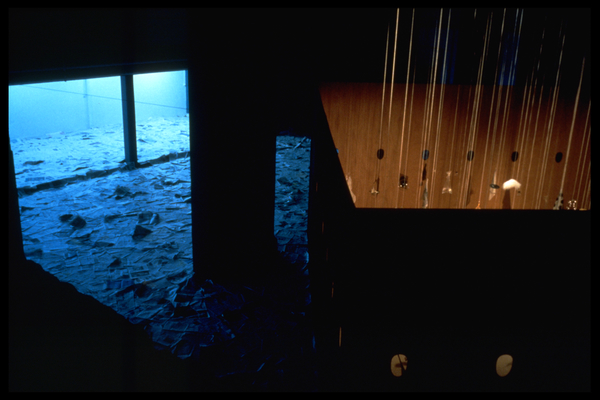Revolving Histories (#bangbang-0831)
Inframince








Inframince
(1995, 1996)
Herbst, Clarissa; Rust, Dominique
Rust, Dominique (Performer)
Leimbacher, Wuz (Klang)
Wrage, Susanne-Maria (Tonbandstimme)
Müller, Hanspeter (Tonbandstimme)
Leimbacher, Wuz (Klang)
Wrage, Susanne-Maria (Tonbandstimme)
Müller, Hanspeter (Tonbandstimme)

Tags
1995, 1996
Fotoserie (Reihenfolge am Ende vom Dateinamen benennen!) / Photo series (name sequence at the end of the file name!)
Staging
Body and space
Experimental
Daily objects
Body and object
Exhibition space

In "Inframince", the audience enters a huge dark room in which a sea of newspapers is swirling around. The sounds of a storm interspersed with sounds are loud. In this hall is an installation (7x7m). Strong light emanates from it. It is supposed to attract people. The four walls of the installation are painted black on the outside and raw on the inside. The walls are each provided with eight openings. These holes are the size of a face and allow the viewer to see from the outside to the inside. This space, which looks like a room, symbolizes the inversion of an inner world. The walls form the membrane. The viewer becomes the link. His gaze connects the outer with the inner landscape. The viewers become voyeurs on the one hand and part of the installation on the other. The result is a portrait gallery that represents a sequence of mirrors for the figure. The search for oneself - the preoccupation with the mirror image - the mask - a fixed point in the chaos. The floor of the installation is made of foam rubber.
This strongly influences the quality of the figure's movement (amorphous/somnambulistic/aquarium-like). Like the walls, the floor surface serves as a film projection surface. The figure holds some of the objects attached to rubber cords (approx. 100 pieces). They slip away from her. An alphabet of objects form a framework/skeleton of memories, feelings, signs and associations. Familiar objects next to abstract ones. Heavy objects that dig into the softness of the floor material - leaving traces that only slowly disappear again - like images that burn themselves into our memory only to fade again over time. Skin marks. Imprints. Hollows. Dents. Cuts. Injuries and scars. Light, delicate, transparent and fragile objects that are easy to move. By slipping away, the figure is deprived of orientation and the railings of being (hanging and floating are states of ambivalence and doubt).
The objects are made of wax/paper/felt/wood/hair/lead/wire/plastic/rubber/fabric etc. (1995)
This strongly influences the quality of the figure's movement (amorphous/somnambulistic/aquarium-like). Like the walls, the floor surface serves as a film projection surface. The figure holds some of the objects attached to rubber cords (approx. 100 pieces). They slip away from her. An alphabet of objects form a framework/skeleton of memories, feelings, signs and associations. Familiar objects next to abstract ones. Heavy objects that dig into the softness of the floor material - leaving traces that only slowly disappear again - like images that burn themselves into our memory only to fade again over time. Skin marks. Imprints. Hollows. Dents. Cuts. Injuries and scars. Light, delicate, transparent and fragile objects that are easy to move. By slipping away, the figure is deprived of orientation and the railings of being (hanging and floating are states of ambivalence and doubt).
The objects are made of wax/paper/felt/wood/hair/lead/wire/plastic/rubber/fabric etc. (1995)
automatically translated from german

Additional
Die Performance wurde an im Oktober/November 1995 und im März 1996 im Westend an der Limmatstrasse im ehemahligen Schoellerareal in Zürich gezeigt. Die Besucherzahl war beschränkt da in den vier Wänden der Installation jeweils acht Gesichtformen ausgesägt waren. Die Super-8 Filme haben Clarissa Herbst und Dominique Rust aufgenommen.
Der Flyer für das Projekt hat genau die Form und Grösse der ausgesägten Löcher der Wände. Beim Plakat ist ebenfalls die Form ausgestanzt. Es befindet sich auch in der Plakatsammlung des Museums für Gestaltung in Zürich.
Zur Figur in unseren Arbeiten: Die Bewegungen, Aktionen und Texte entfernen sich von der herkömmlichen schauspielerischen Darstellung. Es existiert keine dramaturgische Entwicklung - keine Geschichte. Die Figur ist einerseits Teil des Gesamtbildes - der Installation und andrerseits verbindet und bündelt sie die verschiedenen Ausdrucksformen.

Remark
Fotos von Performance Christian Altorfer

place: Westend/ Schoeller-Areal Zürich
Dokumentationstyp: Performance/Aktion für die Kamera / Performance/Action for the Camera
Alternative
Fotos von Christian Altorfer

Medium
Fotoserie (Reihenfolge am Ende vom Dateinamen benennen!) / Photo series (name sequence at the end of the file name!)
Dauer: ca. 60.00

























